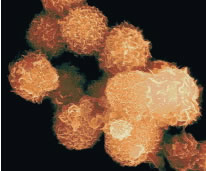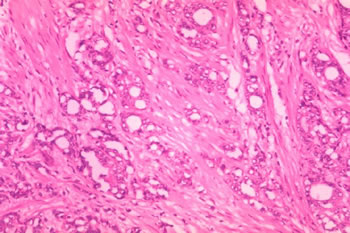 |
Prostate Cancer
Prostate cancer is malignant and uncontrolled
growth of cells in the prostate, a small gland located between
the bladder and the penis.
Compared to other types of cancer, prostate cancer is usually
slow growing and dependent on testosterone to grow. This cancer
usually involves the epithelial cells of the inner lining of the
prostate gland, and is therefore classified as an adenocarcinoma.

Prostate cancer cells.
Prostate Cancer Symptoms
In early stages, there are no noticeable symptoms of prostate
cancer. It is estimated that between 60 to 70% of men of 80 years
of age or older living with prostate cancer do not show symptoms.
In later stages, prostate cancer symptoms include:
- Inability to urinate
- Difficulty in starting to urinate (hesitancy in urinating)
- Weak urine stream or dribbling
- Frequent urination
- Waking up in the middle of the night to urinate or due to
urges to urinate (also called nocturia)
- Pain or burning sensation while urinating (called dysuria)
- Blood in the urine (hematuria)
- Feeling that the bladder is not empty even after multiple
attempts of urination
- Pain in the lower back, hip or pelvis, abdomen, and upper
thighs.
These symptoms are similar to other diseases, such as benign
prostatic hyperplasia, prostatitis, and urinary tract infection.
In advanced cases of prostate cancer, where the cancer has metastasized
or spread to other organs of the body, the following symptoms
may be present:
- Loss of appetite and weight loss
- Swelling or edema of the legs and feet
- Pain in the bone, especially in the abdomen, pelvis, and lower
back.
Prostate Cancer Diagnosis
Your doctor would use the following tests to diagnose prostate
problems:
- Digital rectal exam
In this exam, enlarged prostate can be felt by inserting a lubricated
finger into the rectum.
- Urinalysis or laboratory analysis of the
urine
- Prostate-specific antigen (PSA) test
In this test, elevated level of prostate-specific antigen (PSA)
in the blood may indicate an enlargement, infection, and also
prostate cancer.
PSA test is often used as a screening test for prostate cancer,
however, positive result does not equal proof of cancer because
other prostate conditions also can cause high PSA levels.
- Prostate Biopsy
To confirm the presence of prostate cancer, a sample of the
prostate tissue is taken.
In this procedure, a needle is inserted through the rectum (called
a transrectal biopsy), through the urethra, or through the perineum
(the area between the anus and the scrotum). The most common
technique is transrectal, often with the guide of an ultrasound.
 Prostate cancer (adenocarcinoma)
Prostate cancer (adenocarcinoma)
Risk Factors for Developing Prostate Cancer
Although the exact cause of prostate cancer is unknown,
certain risk factors are known to increase the likelihood of developing
this condition:
- Age
Age is the most important risk-factor in prostate cancer. Both
incidence and mortality rate increases significantly with age:
more than 75% of new diagnosis and 90% of death occur in men
older than 65.
- Race / Ethnicity
African Americans are at greater risk of developing and dying
from prostate cancer when compared to Caucasian population in
the United States. On the other hand, Asian men in Japan and
China have much lower incidence of prostate cancer diagnosis.
- Genetics
Family history plays a key role in determining your chances
of developing prostate cancer. Both having relatives diagnosed
before the age of 55 and the number of family member with the
disease increases your risk, for example:
Relative with cancer |
Increase in risk |
1 (brother / father) |
2x |
2 |
5x |
3+ |
Almost certainty |
- Diet
Prostate cancer is more commonly found in countries with high-fat
diet. Indeed, diet maybe the determining factor why Asian men
in China and Japan are at much lower risk of developing this
condition.
- Obesity
Being overweight or having a body mass index or over 32.5 is
a risk factor as well. Weight gain at an earlier age and keeping
that weight on may bring a greater risk of developing the more
aggressive form of prostate cancer.
- Testosterone
While the link between testosterone and prostate cancer is not
well established, it is thought that the growth of the cancer
cells are nourished by testosterone - and thus controlling the
level of this hormone may help prevent or slow down prostate
cancer.
Nevertheless, studies have shown that high testosterone level,
vasectomy, and frequent sexual activities do not cause prostate
cancer.
- Exposure to toxins and carcinogens
Exposure to high levels of cadmium, pesticides such as methyl
bromide, herbicides and cigarette smoke can increase the risk.
Veterans exposed to Agent Orange, a herbicide used to defoliate
trees in jungle warfare, may be twice as likely to develop prostate
cancer.
Prostate Cancer Treatment
Treatment for prostate cancer include:
- Radiation Therapy
In this treatment, high-energy rays or radiactive particles
are used to kill rapidly growing cells, such as cancer cells.
The two forms of radiation therapy are external beam therapy,
where high-energy rays are aimed at the prostate, and interstitial
radiation or brachytherapy, where radiactive materials or seeds
are implanted directly into or near the cancer.
- Surgery
Surgical treatment of prostate cancer usually means removal
of the prostate gland or prostatectomy. This
can be done either through an incision in the lower abdomen
(retropubic approach) or between the rectum and the scrotum
(perineal approach).
With a new technique called laparoscopic surgery,
where a surgical instrument called a laparoscope is inserted into
the abdomen, removal of the prostate gland can be done without
the invasive open surgery.
Watchful Waiting
In many instances, however, your doctor may not
recommend any treatment. Instead, the patient is advised to monitor
the situation closely by having frequent medical checkups, PSA
testing, and biopsies in combination with dietary changes.
This watchful waiting (also called active surveillance, expectant
therapy or simply just observation) is often used since prostate
cancer grows so slowly that a man is likely to die naturally or
of other causes than the cancer itself. If the cancer becomes
a health threat, then the treatment options above may be used.
Reference:
Yahoo!
Health - Prostate Cancer
National Prostate Cancer Coalition
MedlinePlus
- Prostate Cancer
|


